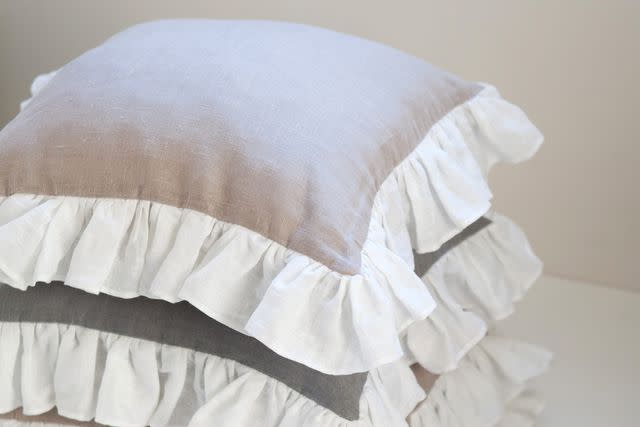Gingham and Ruffles Are Back—Here Are a Few Fresh Ways to Use Them in Your Home
Interior designers share new ways to use these nostalgic, feminine details.

If you're a child of the '80s or '90s, you know the Laura Ashley brand well: Her name immediately brings to mind floral and gingham patterns and ruffles. But Ms. Ashley, who was actually a real person—a British designer born in the 1920s—wasn't the first to dabble in this feminine aesthetic. Dorothy Draper was draping windows, beds, pillows, and even shower curtains in these details since the 1940s.
Ruffles and gingham defined interior design throughout many of our childhoods, during a time when magazines were filled with frilly, checked, and floral spaces. "My love of these feminine details stems from my childhood bedroom in the '80s, which was filled with ruffles and florals," recalls Heather Taylor, the founder of Heather Taylor Home, a company that specializes in ruffled and gingham home goods.
These motifs are back in a big way—partly in thanks to the emergence of maximalism, cottagecore, and all things grandmillennial—but their most recent iterations have a more muted, tailored look. Designers are here for these modern takes. Ahead, they share how to use these nostalgic details in ways that feel fresh, not saccharine.
Related: Both Minimalism and Maximalism Are Trending—Interior Designers Explain the Surprising Coexistence
Why Gingham and Ruffles Are Back
We've come a long way since that ruffled heyday, says South Carolina-based designer Whitney McGregor—but she's still using these patterns and details in her current work. "I still remember my mom's ruffled vanity chair with fringe trim and our wicker framed floral sofas," she says. "Maybe it's nostalgia that I'm after when I use those same methods and materials, but I honestly think those things are just classics that I'll never tire of."
Perhaps they offer some comfort during an age of uncertainty: These feminine, familiar motifs are a nod to an earlier, simpler time—and this nostalgia is taking hold in the design world. "We launched our first ruffle pillow a month after the pandemic started and people went nuts," says Taylor. "We couldn't keep them in stock. I was craving a return to coziness and warmth in my home—and I guess I wasn't alone!"
Bambi Costanzo, an interior designer who is renovating a 103-year-old home in West Virginia with plenty of these details, agrees: "I have loved ruffles and ginghams for as long as I can remember," she says. "Almost every room in my house has a little bit of gingham in it. It's my signature!"

3 Fresh Ways to Incorporate Gingham and Ruffles Into Your Home
If you're a fan of minimalist design or even clean-lined coastal grandmother-inspired interiors, you might be wondering if it's possible to make gingham and ruffles work in a modern home. According to Taylor, McGregor, and Costanzo, it certainly is: All of our experts have advice for those looking to dip their toes into this aesthetic (particularly if it isn't a look you've already been using in your home). Here are three ways to incorporate gingham and ruffles into a contemporary home.

Start With a Small Accent Piece
Starting small is a good approach to almost anything, including interior design trends. Costanzo suggests starting with a gingham tea towel, while Taylor says to try a small pillow, which looks nice on a chair, couch, or bed. "That's usually the gateway item that leads to additional pillows, gingham tablecloths, and quilted placemats!" she says.
McGregor echoes the sentiment of incorporating an easy, non-committal piece first. "Try a vanity or accent chair with a gathered skirt or a gingham throw pillow with ruffled trim or perhaps a scallop lampshade," she says. "Touches of these classic elements can be used with any aesthetic." If you fall in love with the look, this first flirtation might just be the beginning.
Use Pattern and Scale Intentionally
Trying new takes on pattern and scale can make these traditional looks feel fresh. "We play with scale and pattern mixing in a way that makes ginghams, plaids, ruffles, and stripes work in any space," says Taylor. If a bold, chunky check feels too blunt, look for a piece with a smaller repeating pattern—or swap a gathered ruffle with a softer scallop. It's better to tweak these motifs to fit your modern home than force a detail that doesn't make sense there.

Getty Images
Choose the Right Colors
These details may have feminine roots, but they don't need to be translated in overtly sweet colorways—in fact, these days, most gingham and ruffle details aren't. You'll find ginghams in rust orange, deep navy, forest green, and punchy mustards—and you can keep your eyes peeled for ruffled pieces of furniture or curtains in neutral or darker shades for contrast or increased visual interest. "Our color combinations keep these motifs feeling fresh," says Taylor who uses bold reds and pinks next to earthier tones and fresh yellows. A mix of timeless and modern keeps these ruffles and ginghams feeling youthful in a modern home.

